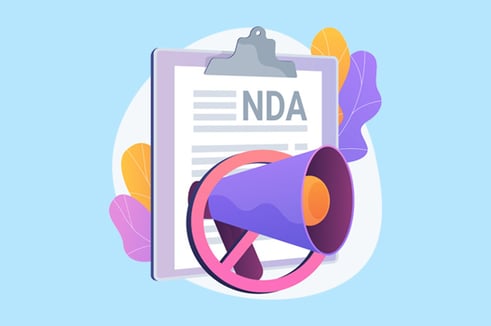The Complete Guide to Nondisclosure Agreements (NDA)
 Chris Daming, J.D., LL.M. : Nov. 4, 2024
Chris Daming, J.D., LL.M. : Nov. 4, 2024
Not sure of the extent that an NDA, also known as a confidentiality agreement (two different terms--same contract), could affect your business? Think of it this way -- without NDAs or confidentiality, almost nothing would get done.
Businesses couldn’t trust each other. Everyone would have access to everyone’s customer lists and sales processes. Employers would constantly fear employees would sell secrets to competitors.
But here’s the good news. Your business can easily protect its secrets, and writing an NDA is almost always simpler than lawyers make it out to be. In 9 out of 10 cases, you can just change a few words and be good to go. We want to help you do that in this post.
First, we’ll do a little bit of background, but if you already understand NDAs and just want to write one, skip ahead to How to Write an NDA.


Legal GPS Pro
Protect your business with our complete legal subscription service, designed by top startup attorneys.
- ✅ Complete Legal Toolkit
- ✅ 100+ Editable Contracts
- ✅ Affordable Legal Guidance
- ✅ Custom Legal Status Report
What’s an NDA?
An NDA, or “nondisclosure agreement,” is a legal contract between two or more parties that tells you what info you or the other party must keep secret. NDAs are used by startups and businesses to cover their ass in case employees, prospective business partners, etc. try to disclose the business’s confidential info. They help protect your company’s trade secrets and other info -- like your business strategy or client contact list -- from being released to the public or competitors.
What Type of NDA Should You Use?
There’s a couple main types of NDAs—unilateral and bilateral. Unilateral means one party is obligated to keep certain info of another party confidential. Bilateral agreements, sometimes called a mutual NDA, mean that each party will each other’s information confidential. Here are some examples:
Unilateral NDA Examples
- Hiring an employee. In most cases, you’ll share confidential information with your employee but they’re not sharing confidential information with you (if they are, make sure they’re not in breach of any other company’s NDA and confidentiality provisions).
- Hiring for help on a project or hiring a consultant.
Bilateral NDA Examples
- Mergers. This is the most obvious example. If you’re thinking about merging with another company, you’ll both want to know information about each other to see if it makes sense.
- Selling your company. If you’re selling your company, you’ll likely want to know details about the buyer, can they pay, will they maintain your vision, etc.
- Collaborating with someone or a company in which you both are desirous of each other’s confidential information.
- Two companies working together on a project.
How to Write an NDA
First, make sure you have our template. We’ll cover specifically a “unilateral NDA” since those are the most common. Below we'll go through step-by-step each provision in the template.
Definition of Confidential Information
For your NDA, you have to define what information you’re declaring as “confidential.” The reason is simple -- imagine an employer saying, “Everything I tell you in the next 2 years is confidential.” A year later you’re about to quit and your employer tells you he thinks it’s going to rain tomorrow. Your employer finds out that later that night, you told your mutual friend that it’s going to rain tomorrow. Did you disclose confidential information? Of course not!
A court would never uphold that broad of a confidential clause. But at the same time, if you make the definition too narrow, then you could accidentally disclose confidential information that the receiving party (the party “receiving the information”) would then be able to share with anyone.
Most businesses use a standard definition like the one in the template, but if you’re not sure, check out our more in-depth post about how to define confidential information in your NDA.
Have you already disclosed any information?
If you have information already disclosed to the other party, no problem! We’ll take care of you. You’ll want to tweak the template in a couple spots. Check out “what happens if I’ve already disclosed confidential information” to learn exactly how to do this. Otherwise, let’s move onto the description of purpose.
NDA Purpose
You’ll notice on the template -- and on all NDAs -- that you need to describe the “purpose” of the NDA. You might say something like, “to manufacture a prototype product for the disclosing party,” or “to evaluate the potential business relationship between the two parties.” The purpose is important because it indicates for what reason the recipient of the confidential info can use the information.
For example, let’s say you want to hire a developer to help you build your website. You share with him your business plans so he has a better idea of the type of website to build. You’d want to narrow the purpose in that scenario to be in connection with the “development of. . .” and then describe the specific parts of the website the developer will be developing.
Without the restriction of that purpose, the developer might use the confidential information to create a separate, similar company and profit off of the business’s confidential info.
In most cases, however, the language in the template (“evaluating the parties’ capabilities of pursuing one or more business opportunities”) is fine.


Legal GPS Pro
Protect your business with our complete legal subscription service, designed by top startup attorneys.
- ✅ Complete Legal Toolkit
- ✅ 100+ Editable Contracts
- ✅ Affordable Legal Guidance
- ✅ Custom Legal Status Report
Limited Access to Confidential Information
You’re giving your information to the “Recipient,” but what happens if the Recipient is actually a company? Or what happens if the recipient needs to run some information by his lawyer? These types of issues are addressed in the “Limited Access” section of your NDA.
In most cases, the language in the template is fine. But in general, think about who needs to know the information, and limit the use of the information to those people. Whoever the recipient discloses the information to, the recipient should make sure that person also signs an NDA agreeing to the same terms.
Exclusions in the NDA
The next NDA section is “exclusions.” You need these exclusions to increase the likelihood of your NDA being upheld by a court (if it came to that). The only one to consider removing is 4(a)(1) -- and only if you’ve already disclosed confidential information to the recipient. Otherwise, these exclusions as written should work in most cases.
Term of NDA Agreement
The NDA could simply cover one transaction that lasts a few days, or you might want it to last indefinitely. Whichever time period covers the anticipated relationship, that is how long the agreement lasts. Often an NDA lasts longer than the particular transaction or relationship itself, specifically, for as long as the trade secret remains secret.
You probably want to include a provision that specifically states that the trade secret must remain protected even after a business relationship or other contractual agreement has ended. If you have no clue what to put here, know that the average time period is between one to five years. And remember that the time period needs to last as long as you need the information to remain confidential.


Legal GPS Pro
Protect your business with our complete legal subscription service, designed by top startup attorneys.
- ✅ Complete Legal Toolkit
- ✅ 100+ Editable Contracts
- ✅ Affordable Legal Guidance
- ✅ Custom Legal Status Report
Return of Confidential Information
This provision is great because it ensures you’ll get your information back once the NDA term is complete. It made a lot more sense before when everything was in paper form; but you can use this provision to tell the recipient to delete any confidential information you disclosed once the term ends.
Governing Law
This section of the NDA indicates what state’s contract law will apply to your NDA. In almost every case, people use their home state here. Similarly for “jurisdiction,” that just means what court will be responsible for handling the case if there is a dispute over the NDA. Most people choose their home state for that as well.
Signing an NDA
When you’re signing the NDA, make sure you are signing as the right party. Long story short, if you’re signing on a company’s behalf, you’ll have the company listed as the signatory, your name under the signature line, and “By: “ to the left of the signature line. If you’re not sure, learn more about how to sign a contract.
Make sure your NDA has consideration
For your NDA to be a valid contract, it has to have consideration. If you’re hiring someone new or giving someone information for the purpose of determining if you guys could merge companies, then there’s consideration.
In the employee example, you’re offering employment in consideration for the employee to keep the info confidential. For the merger example, you’re offering info to determine if you can do a merger in consideration for the other party to keep the info confidential.
However, if you’ve already given someone confidential info, like an employee or a contractor, and don’t plan on providing them any additional confidential information, then technically, they might not stand to gain anything from signing the NDA. In this case, you’ll want to offer “consideration.”
One easy trick is to just pay the person $5 in exchange for their agreement to keep the information confidential.
Someone breached my NDA: What do I do?
If someone breaches your NDA, you have a breach of contract lawsuit against them. This means that you can sue them for any damages you incurred because of their breach. Sometimes all you want to do is get them to stop using or giving out the info. In that case, you’ll file for injunctive relief to restrain them from continuing to breach the contract.
Do you need a lawyer for NDAs?
The biggest question now is, "Do you need a lawyer for NDAs?” For most businesses and in most cases, you don't need a lawyer to help with NDAs. Instead, many business owners rely on Legal GPS Pro to help with legal issues.
Legal GPS Pro is your All-In-One Legal Toolkit for Businesses. Developed by top startup attorneys, Pro gives you access to 100+ expertly crafted templates including operating agreements, NDAs, and service agreements, and an interactive platform. All designed to protect your company and set it up for lasting success.

Legal GPS Pro
Protect your business with our complete legal subscription service, designed by top startup attorneys.
- ✅ Complete Legal Toolkit
- ✅ 100+ Editable Contracts
- ✅ Affordable Legal Guidance
- ✅ Custom Legal Status Report
| Popular | |
| Premium Template Single-use Template |
Legal GPS Pro Unlimited Access, Best Value |
|
|
| Get Template | Learn More |
| Trusted by 1000+ businesses | |
Table of Contents
